The Chilling Legacy of the Son of Sam

Introduction
The story of the Son of Sam is one of the most notorious criminal cases in American history, famously linked to the prolific serial killer David Berkowitz. Operating in New York City during the mid-1970s, Berkowitz’s spree instilled fear and panic in a city already grappling with socioeconomic challenges. Understanding this dark chapter in crime history is crucial, not only for its psychological impact on society but also for its influence on law enforcement and crime prevention efforts.
The Crimes
From July 29, 1976, to July 31, 1977, Berkowitz claimed the lives of six people and wounded seven others in a series of shooting attacks primarily targeting young couples parked in vehicles. His violent acts seemed random, yet Berkowitz left terror in his wake. The media dubbed him the “Son of Sam” after he sent a series of letters to local newspapers taunting the police while signing them in this chilling moniker. In one of these letters, he mentioned a demonic dog commanding him to kill, which led the public to believe he was mentally disturbed, complicating the image of a fearsome predator.
The Investigation
The investigation to capture the Son of Sam was unprecedented, sparking a massive manhunt. NYPD squads worked tirelessly, collecting evidence and following leads, all while the city was on high alert. Finally, Berkowitz was apprehended on August 10, 1977, less than a month after his final attack, when police linked him to a parked car through a traffic violation. His arrest followed a series of tips from the public triggered by the growing media coverage of the mysterious killer.
The Aftermath
Upon his arrest, Berkowitz confessed to all the killings, declaring he was “just a boy who was being influenced by the devil.” He was ultimately sentenced to 25 years to life in prison. As a result of the Son of Sam case, New York City implemented new measures for community safety and crime prevention. Furthermore, the media frenzy surrounding the crimes led to ethical debates on how sensationalized coverage can influence public perception and investigations in criminal cases.
Conclusion
The legacy of the Son of Sam continues to resonate, reminding us of the fragility of safety and the impact of crime on society. Today, as true crime interest grows, so does the exploration of Berkowitz’s psychological background, societal influences, and the implications for modern law enforcement tactics. Understanding such historical cases is essential not just for academic discussions but for informing ongoing dialogues about crime and prevention in contemporary society.









